Для работы проектов iXBT.com нужны файлы cookie и сервисы аналитики.
Продолжая посещать сайты проектов вы соглашаетесь с нашей
Политикой в отношении файлов cookie
В мире, где Windows 10 и Windows 11 стали надёжными спутниками в работе и
развлечениях, есть одно «но» — встроенная реклама, которая порой
действует на нервы. Эти операционные системы от Microsoft, несмотря на свои преимущества, иногда могут
превратиться в рекламные платформы, подсовывая назойливые подсказки и
всплывающие окна.
Можно, конечно,
прибегнуть к сторонним инструментам для отключения этих рекламных объявлений
одним кликом, но это не всегда лучшее решение. Такие «инструменты
конфиденциальности» часто зависят от других настроек Windows, и использование этих универсальных
средств, многие из которых вмешиваются в реестр, может привести к сложностям в
понимании того, почему другие настройки ведут себя неожиданно.
Лучше всего взять
дело в свои руки и отключить рекламу самостоятельно. Это даст полный контроль
над процессом и упростит дальнейшее устранение возможных проблем. Большинство
этих рекламных объявлений можно легко отключить через меню настроек Windows.
Однако стоит
помнить, что Microsoft имеет
тенденцию возвращать рекламу в новые места и восстанавливать
«рекомендуемые» приложения с обновлениями Windows. Это означает, что время от времени может
потребоваться проверить настройки, чтобы убедиться, что всё остаётся
по-прежнему. Хотя предложенные шаги могут не убрать всю рекламу, они должны
заметно уменьшить её количество.
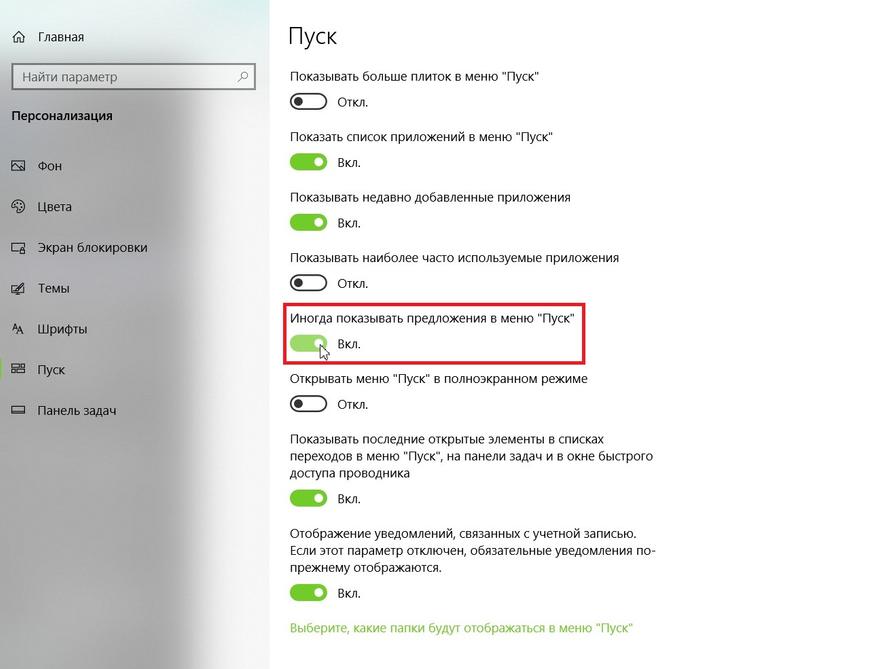
С течением
времени Стартовое меню в операционных системах Windows претерпело значительные изменения. Несомненно,
некоторые из нововведений были полезными, но среди них также появились и
недостатки, такие как «предложения» от Microsoft, которые иногда могут быть навязчивыми и
направлены на продвижение продуктов компании. Особенно заметно это становится,
если вы предпочитаете браузеры, отличные от Edge, и получаете рекомендации перейти на продукты Microsoft.
Для пользователей
Windows 10 процесс отключения
этих рекламных предложений довольно прост. Вам нужно лишь зайти в раздел
«Настройки», затем перейти в категорию «Персонализация» и
выбрать вкладку «Старт». Здесь вы найдете опцию «Иногда
показывать предложения в меню «Пуск»», которую можно отключить, сняв
галочку.
В случае Windows 11, этот процесс несколько отличается.
Настройка называется «Показывать рекомендации для советов, ярлыков, новых
приложений и прочего» и находится в аналогичном разделе.
Если вас
беспокоят живые плитки в Стартовом меню Windows 10, особенно те, которые установлены по умолчанию
и не приносят пользы, вы можете легко их отключить. Просто кликните правой
кнопкой мыши по ненужной плитке, выберите «Дополнительно» и затем
«Отключить живую плитку». Таким образом, вы уберете анимацию и
сделаете ее обычным ярлыком. Если же вы хотите полностью удалить приложение, то
просто выберите «Удалить» после щелчка правой кнопкой мыши по плитке.
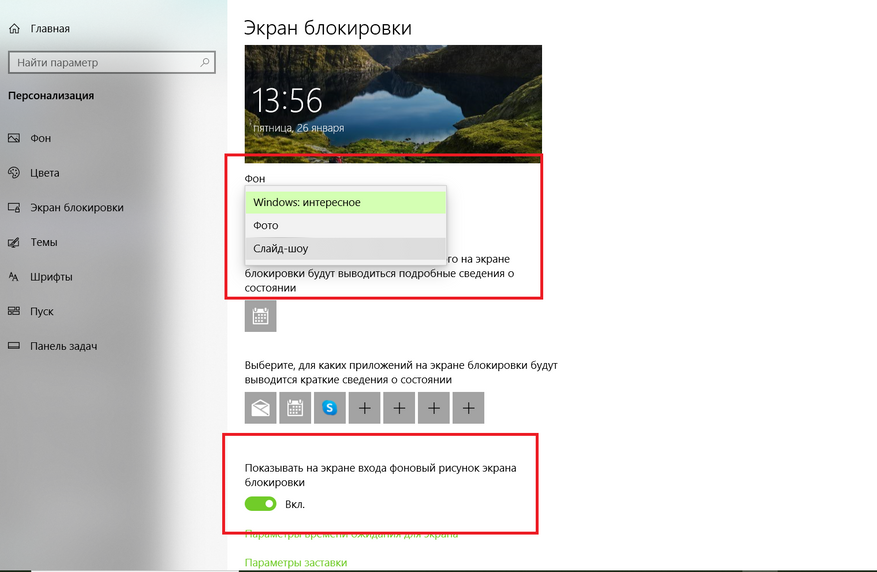
Экран блокировки
в Windows, к сожалению, тоже
не лишён недостатков. Если на экране блокировки установлено отображение
изображения или слайд-шоу, Microsoft часто добавляет на экран текстовые сообщения. Иногда это «интересные
факты» о местности, изображённой на фотографии, а иногда —
«советы» по использованию устройства, например, предложения перейти
на Edge или использовать
учётную запись Microsoft
вместо локальной учётной записи.
Для того чтобы
экран блокировки показывал только выбранное вами изображение без дополнительных
предложений и советов, необходимо выполнить несколько простых шагов. Сначала
зайдите в раздел «Настройки», затем выберите
«Персонализация» и перейдите к «Экрану блокировки». Здесь
вам нужно будет изменить настройку фона с «Windows» на опцию «Изображение» или
«Слайд-шоу».
После этого
отключите функцию «Получать интересные факты, советы и другие сведения от Windows и Cortana на экране блокировки», чтобы убрать лишние
элементы и сосредоточиться исключительно на вашем фото.
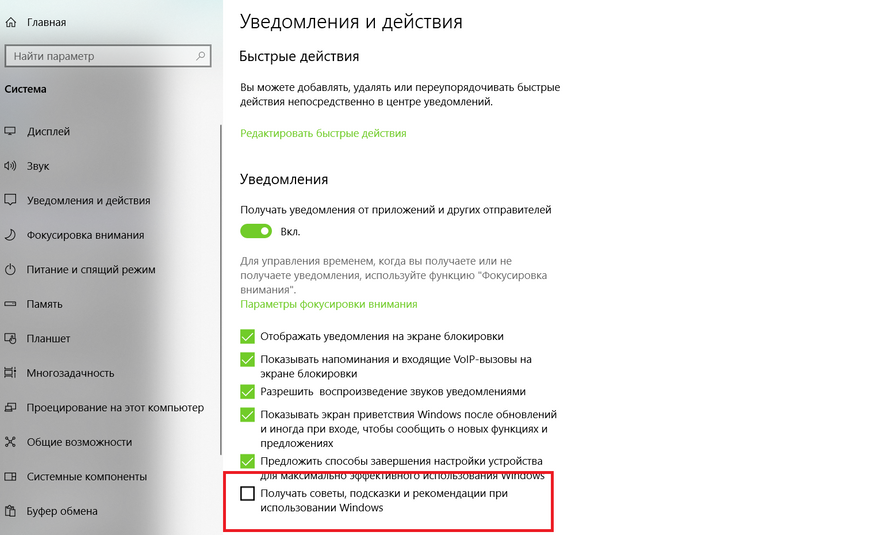
Иногда в Windows могут появляться всплывающие уведомления,
убеждающие перейти на Edge
или присоединиться к программе Microsoft Rewards. Чтобы
избавиться от них в Windows
10 для этого перейдите в раздел «Настройки», выберите
«Система» и затем «Уведомления и действия». Здесь найдите и
отключите опцию «Получать советы, подсказки и предложения при
использовании Windows».
Кроме того, вы можете отказаться от функции
«Показать приветствие Windows», которая запускает обучающие туры после обновлений, а также от
«Предложений по завершению настройки устройства».
В Windows 11 процесс управления этими уведомлениями
слегка отличается. Здесь вам нужно открыть «Настройки», перейти в
«Систему» и затем в «Уведомления». Прокрутите вниз до
раздела «Дополнительные настройки» и отключите там «Показать
приветствие Windows»,
«Предложения по максимальному использованию Windows» и «Получение советов и
предложений».
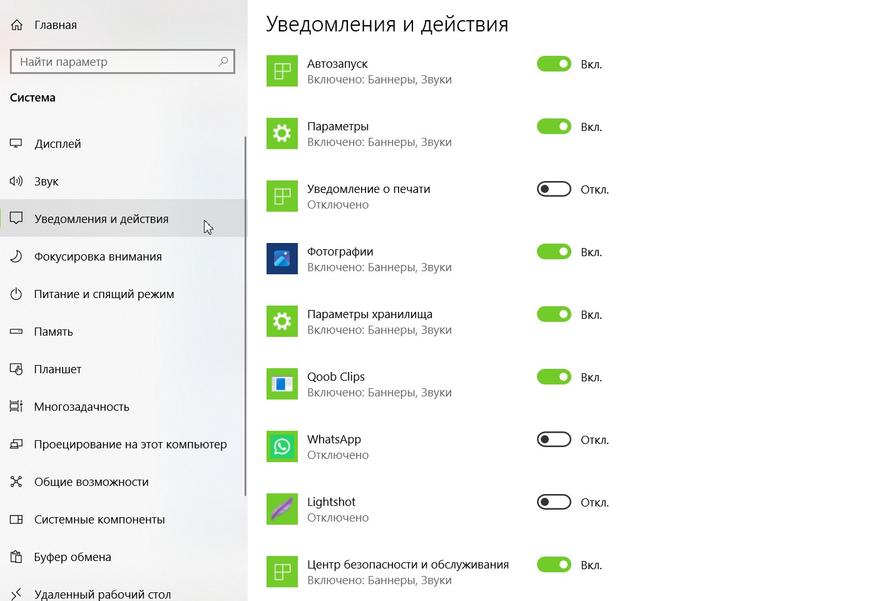
Стоит помнить,
что некоторые «рекламные» уведомления, которые появляются на экране,
могут не иметь отношения к Microsoft. Они могут быть связаны с предустановленным программным обеспечением
(блотваром), установленным производителем вашего компьютера. Если вы
сталкиваетесь с навязчивыми уведомлениями, откройте «Настройки» >
«Система» > «Уведомления» и прокрутите вниз до списка
приложений. Выясните, приходят ли сообщения от каких-либо из этих приложений. Есть
ли среди них приложения, которые вы не узнаёте?
В Windows 11 сложно определить, для чего
предназначено каждое приложение, поэтому может потребоваться поиск в интернете
для получения дополнительной информации. Например, работая на ноутбуке Dell, можно обнаружить, что такие приложения,
как SupportAssist, My Dell и Partner Promo, добавлены производителем. В случае с Lenovo ThinkPad есть Lenovo Vantage. Эти программы можно отключить (и
удалить).
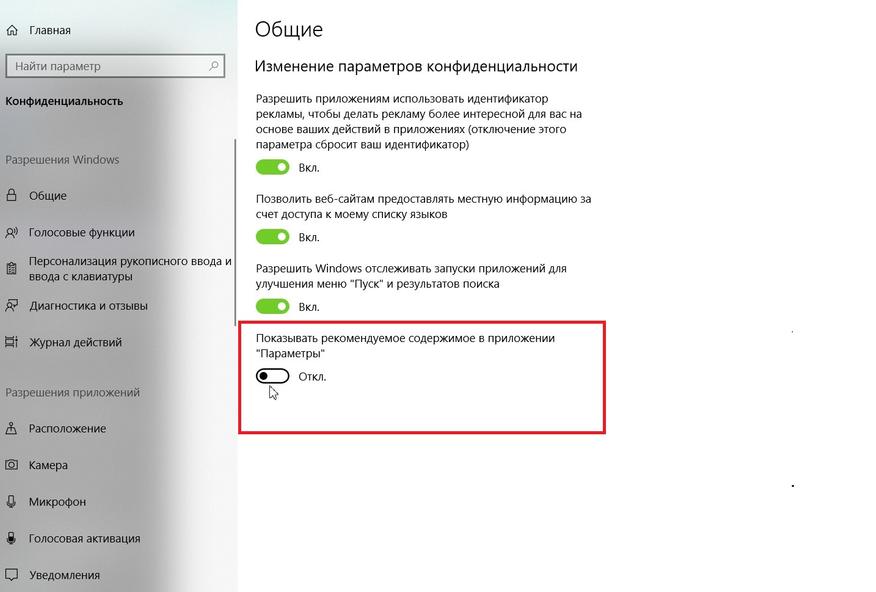
Microsoft начал
использовать приложение «Настройки» в качестве рекламного пространства для
предложения своих приложений пользователям.
Если вы не хотите видеть эти рекомендации,
просто перейдите в «Настройки» > «Конфиденциальность»
> «Общие» и отключите опцию «Показывать рекомендуемое
содержимое в приложении «Параметры»».
Это позволит
избежать ненужных предложений и сосредоточиться на настройках, которые
действительно важны для вас.
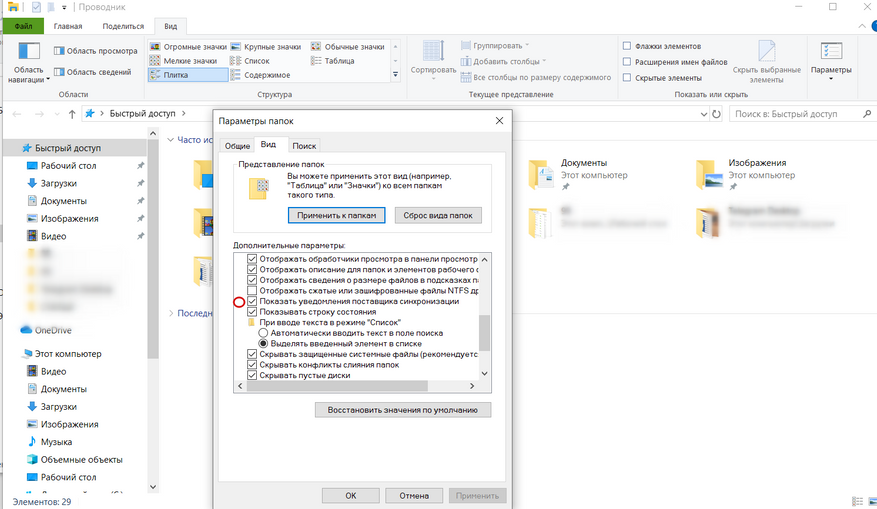
Кажется, что ни
один уголок Windows не
остался без рекламы, и даже Проводник не стал исключением. В своих попытках
заинтересовать пользователей подпиской на OneDrive и Office 365, Microsoft начала
продвигать эти сервисы прямо во время просмотра файлов на жёстком диске. Но от
этих рекламных уведомлений можно избавиться.
В Проводнике Windows 10 щелкните «Вид» >
«Параметры» > «Изменить параметры папок и поиска». В Windows 11 откройте меню с тремя точками и
щелкните «Параметры». Затем в появившемся окне перейдите на вкладку
«Вид». Прокрутите вниз до опции «Показывать уведомления
синхронизируемого провайдера» и снимите эту галочку. Это должно
предотвратить появление рекламных уведомлений в Проводнике в будущем.
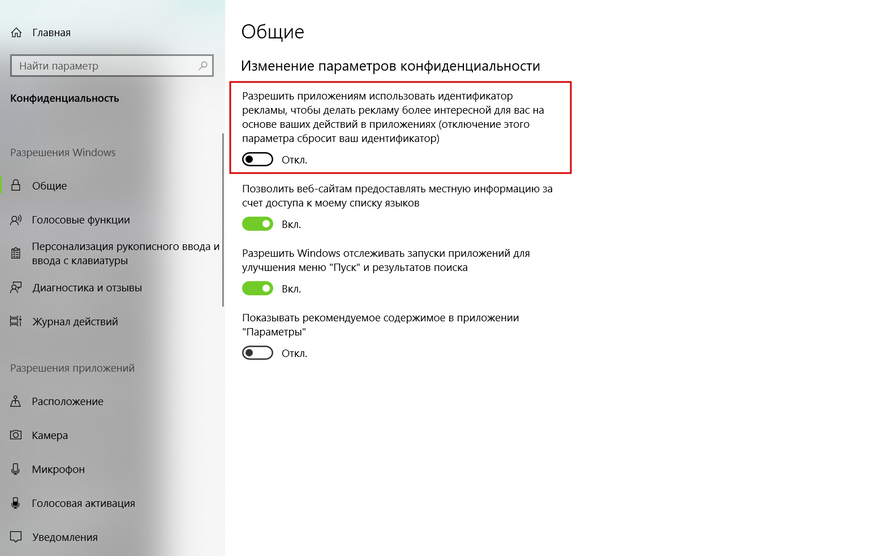
Windows
использует рекламный идентификатор (Advertising ID), чтобы отслеживать
интересы пользователя и показывать более релевантную рекламу в приложениях. В
процессе отключения встроенной рекламы в Windows также может быть полезно отключить эту функцию.
В Windows 10 перейдите в «Настройки» >
«Конфиденциальность» > «Общие» и отключите опцию
«Позволять приложениям использовать мой рекламный идентификатор»,
если вы предпочитаете видеть ненаправленную рекламу.
В Windows 11 эта опция называется «Позволить
приложениям показывать мне персонализированную рекламу с использованием моего
рекламного идентификатора». Отключение этой функции поможет снизить
уровень персонализации рекламы, которую вы видите в приложениях.
Итак, мы
рассмотрели ряд способов, как избавиться от встроенной рекламы в Windows 10 и Windows 11. Отключение рекламы в Стартовом меню, на экране
блокировки, в уведомлениях, Проводнике, а также отказ от персонализированной
рекламы — все эти меры помогут сделать вашу работу на компьютере более
комфортной и менее раздражающей.
Помните, что хотя
некоторые из этих настроек могут казаться малозначительными, в совокупности они
могут значительно улучшить ваш пользовательский опыт. Ведь в конце концов,
каждый из нас хочет, чтобы его компьютер служил надежным инструментом для
работы и развлечений, а не был источником нежелательной рекламы и беспокойства.
Сделайте эти
простые настройки, и вы заметите, как ваша повседневная работа на компьютере
станет более приятной и продуктивной.
Многие пользователи стали замечать, что свежая версия Windows 10 начала показывать рекламу на экране блокировки, в различных приложениях, а также в браузере. Давайте посмотрим, как самостоятельно отключить все рекламные банеры в Windows 10.
Как отключить рекламу на экране блокировки
Когда функция Spotlight (Заставка) включена, она может рекламировать сторонние приложения и продукты из Магазина Windows. В то время, как приложение Заставка должно загружать из сервиса Microsoft и демонстрировать на экране блокировки красивые изображения, такая подмена может многим не понравиться. Но вы можете отключить продвигаемые рекламные объявления на экране блокировки. Для этого сделайте следующее:
Откройте приложение «Пуск» и нажмите «Параметры». На открывшейся странице нажмите «Персонализация». В разделе «Фон» можно отключить Заставку, просто выбрав другой параметр, например «Фото» или «Слайд-шоу». Это отключит Windows Заставку и ее рекламу полностью.
В разделе «Экран блокировки» можно выбрать режим «Фото», а ниже отключить параметр «Отображать забавные факты, советы, подсказки и другую информацию на экране блокировки».
Как отключить автоматическую установку рекомендованных приложений
Благодаря обновлению Windows 10 Anniversary Update новая Windows 10 начала активно продвигать приложения прямо в меню «Пуск». Даже не открывая Магазин приложений и не спрашивая разрешения пользователя, операционная система устанавливает некоторые игровые приложения, такие как Candy Crush Soda Saga, Minecraft: Windows 10 edition, Flipboard, Twitter и многие другие.
Чтобы запретить такую установку, нужно кое-что изменить в настройках реестра. Для этого запустите редактора, набрав в меню Пуск «regedit» и нажав Enter. Далее найдите в реестре строку (можете скопировать ее и вставить в адресную строку редактора реестра):
[HKEY_CURRENT_USER\Software\Microsoft\Windows\CurrentVersion\ContentDeliveryManager]
и поменяйте у параметра «SilentInstalledAppsEnabled» значение на «0» (без кавычек).
Изменения вступят в силу после перезагрузки Windows.
Как отключить предложения для сенсорных и черно-белых Ink дисплеев
С обновлением Windows 10 Creators, Microsoft добавила в систему новую функцию, чтобы расширить охват устройств с сенсорными экранами с поддержкой пера и Ink-дисплеями. После этого операционная система может иногда показывать вам рекомендации по приложениям для девайсов, совместимым с оборудованием Ink, подключенным к вашему ПК. Но в настройках ОС имеется соответствующая опция, позволяющая включать или отключать такие предложения. Если вам нужно отключить ее, то пройдите по следующему пути:
Пуск -> Параметры -> Устройства -> Перо & Windows Ink
Для ноутбуков с поддержкой пера здесь находится опция «Показать рекомендуемые предложения приложений». В версии для ПК без сенсорного экрана здесь нашлись лишь настройки шрифта для рукописного ввода.
Как отключить рекламу в Проводнике
В Windows 10 build 14901 Microsoft представила несколько новых функций в Проводнике. Теперь это приложение может показывать советы об изменениях в Windows 10 с помощью уведомлений, которые появляются прямо поверх приложения в правой части трея. Эта функция называется «Уведомления поставщика синхронизации». Чтобы отключить рекламу в Проводнике в Windows 10, выполните следующие действия.
Откройте Проводник, перейдите на вкладку «Вид» ленты верхнего и нажмите кнопку «Параметры». Откроется диалоговое окно «Параметры папок». Перейдите на вкладку «Вид» и прокрутите список «Дополнительные настройки», пока не увидите параметр «Показать уведомления поставщика синхронизации». Снимите флажок, как показано ниже, чтобы отключить уведомления.
Как отключить предложения приложений (реклама) в меню «Пуск»
Windows 10 может показывать вам «рекомендации» для установки или покупки приложений прямо в меню «Пуск». Они выглядят как реклама приложения в отдельном окне или как рекламная плитка, появляющаяся в списке приложений слева. Некоторые из этих приложений могут быть не бесплатными, но они все еще отображаются. Если вы не хотите их видеть, вот можете отключить предлагаемые приложения, кликнув по ним правой кнопкой мыши и нажать «Дополнительно / Параметры».
Quick Links
-
Stop Suggested Apps From Appearing in the Start Menu
-
Get Rid of Nagging Taskbar Pop-ups
-
Prevent Notification Ads From Appearing
-
Stop Cortana From Bouncing on the Taskbar
-
Remove Advertisements From File Explorer
-
Banish «Get Office» Notifications
-
Uninstall Candy Crush Saga and Other Automatically Installed Apps
-
Disable Live Tiles and Unpin Windows Apps
-
Avoid the Built-in Solitaire Game
-
Remove Ads From the Windows Ink Workspace
-
Hide App Suggestions in the Share Pane
Windows 10 has a lot of built-in advertising. This isn’t just about the free upgrade offer: Even if you purchase a new PC that comes with a Windows 10 license or spend $200 for a copy of Windows 10 Professional, you’ll see ads in your operating system. You can, however, disable a lot of it.
Disable Lock Screen Ads
Windows 10 now displays ads on the lock screen via Windows Spotlight. Sometimes, Windows Spotlight will just show off cool wallpapers, but it’ll also sneak in advertisements for games like Rise of the Tomb Raider and Quantum Break in the Windows Store.
To get rid of these lock screen ads, head to Settings > Personalization > Lock Screen and set the background to «Picture» or «Slideshow» instead of Windows Spotlight.
You’ll probably also want to disable the «Get fun facts, tips, and more from Windows and Cortana on your lock screen» option here, too.
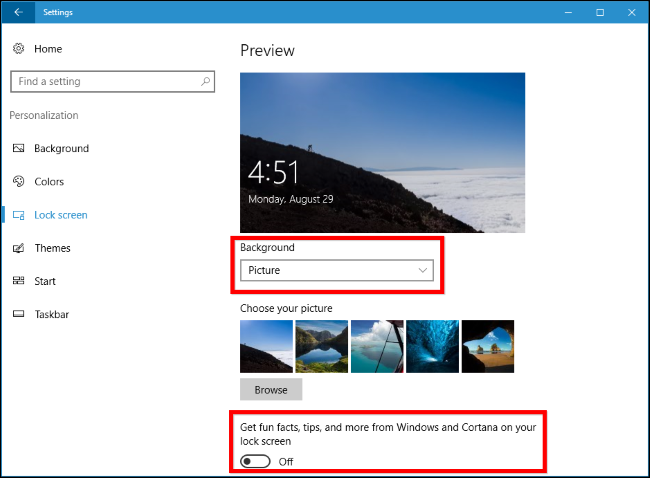
Windows 10 will occasionally show «suggested apps» in your Start menu. Suggested apps aren’t necessarily free, and we’ve seen Microsoft use this feature to advertise $60 PC games from the Windows Store (which, by the way, you shouldn’t buy). But mainly, they just take up valuable space in your Start menu.
To stop suggested apps from appearing in the Start menu, head to Settings > Personalization > Start and set the «Occasionally show suggestions in Start» setting to «Off».
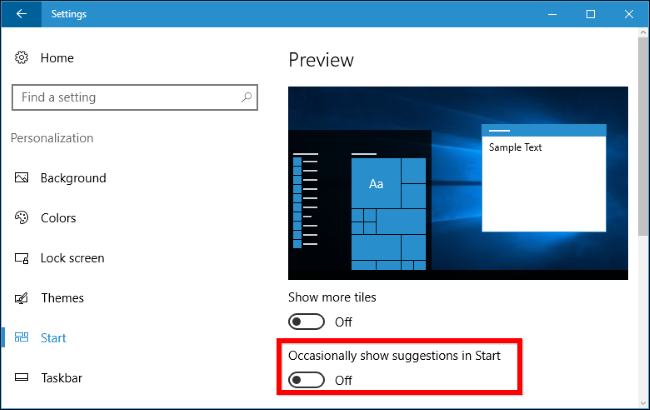
Get Rid of Nagging Taskbar Pop-ups
Windows 10 displays taskbar pop-up ads, which Microsoft calls «tips, tricks, and suggestions». These tips have included recommendations to use Microsoft Edge for better battery life, and an encouragement to use Microsoft Edge so you can earn Microsoft Rewards points.
If you’d like to just use your own preferred applications without Microsoft nagging you, you’ll need to disable these tips. To do so, head to Settings > System > Notifications & Actions and disable the «Get tips, tricks, and suggestions as you use Windows» option.
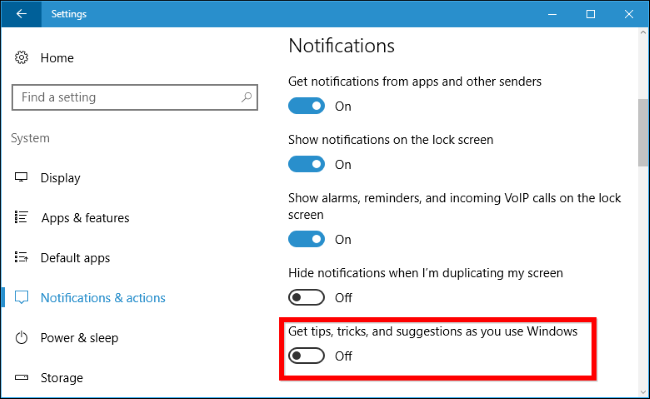
Prevent Notification Ads From Appearing
In the Creators Update, Microsoft added new «suggestions» that appear as notifications. These ads inform you about various Windows features and appear as normal desktop notifications. For example, you might see a notification telling you to set up Cortana. Like other notifications, they’re also stored in the Action Center so you can see them later.
To disable these «suggestions» that appear as notifications, head to Settings > System > Notifications and set «Show me the Windows welcome experience after updates and occasionally when I sign in to highlight what’s new and suggested» to «Off».
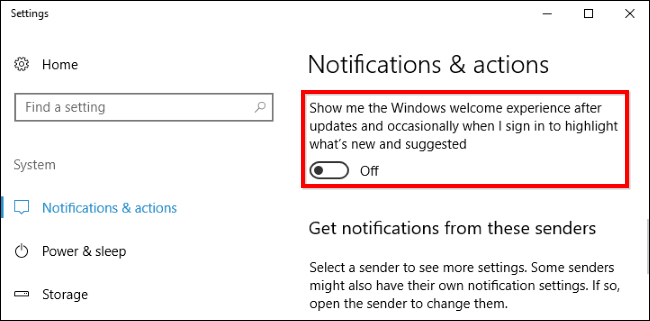
Stop Cortana From Bouncing on the Taskbar
Cortana doesn’t just sit on your taskbar and wait for you to start talking to it. Cortana will regularly bounce in place, encouraging you to try using it.
If you don’t want Cortana nagging you, click the Cortana search bar, click the Settings icon, scroll down, and disable the «Taskbar Tidbits» option under «Let Cortana pipe up from time to time with thoughts, greetings, and notifications in the Search box». From then on, Cortana will sit quietly until you want to use it.
If you don’t want Cortana running at all, you can choose to disable Cortana with a registry or group policy setting. Microsoft removed the old, easy toggle that lets you disable Cortana with the Anniversary Update, but the registry and group policy tricks still work.
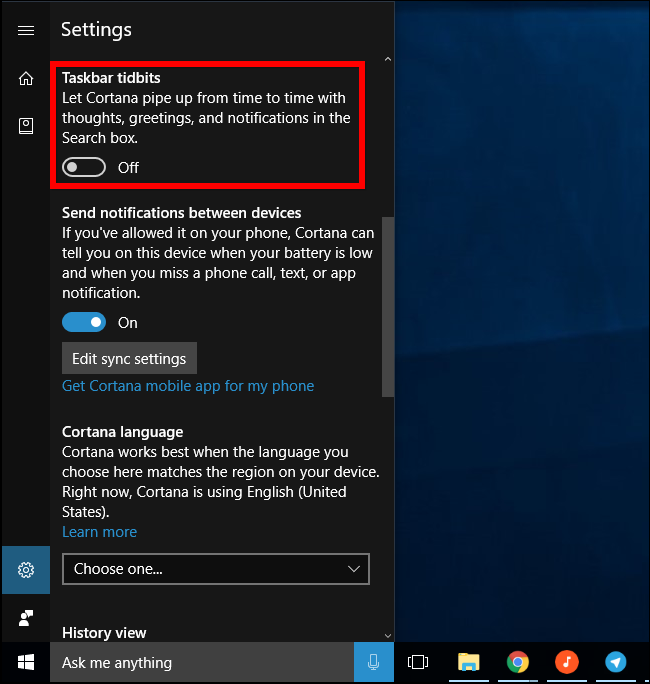
Remove Advertisements From File Explorer
As of the Creators Update, Microsoft is now displaying ads pushing OneDrive and Office 365 with a banner at the top of the File Explorer window. These banners can be disabled in File Explorer’s options window.
To disable these options, open File Explorer’s options window by clicking the «View» tab at the top of a FIle Explorer window and clicking the «Options» button on the ribbon. Click the «View» tab at the top of the Folder Options window that appears, scroll down in the list of advanced settings, and uncheck the «Show sync provider notifications» option.
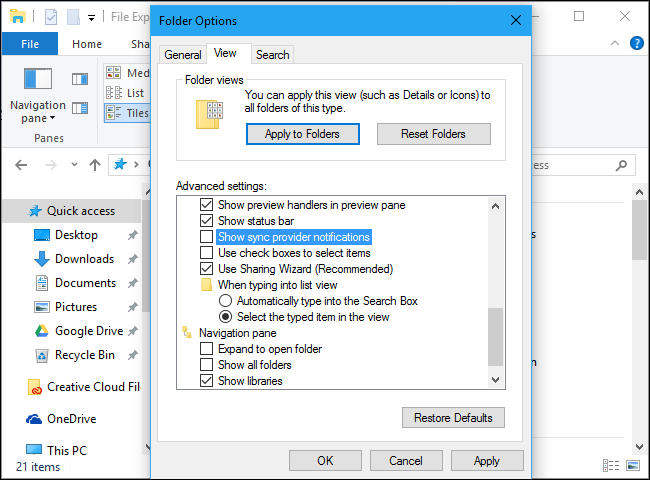
Banish «Get Office» Notifications
Windows 10 includes a «Get Office» application that sits there, providing notifications suggesting you download Office 365 and enjoy a month-long free trial.
To stop those Get Office notifications, head to Settings > System > Notifications & Actions, scroll down, and set notifications for the «Get Office» app to «Off». You can also simply find the Get Office app in your Start menu, right-click it, and select «Uninstall». However, it may come back when you update Windows 10 in the future.
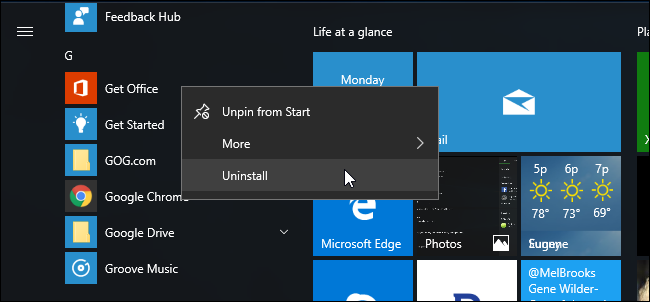
Uninstall Candy Crush Saga and Other Automatically Installed Apps
Windows 10 «automatically downloads» apps like Candy Crush Soda Saga, Flipboard, Twitter, and Minecraft: Windows 10 Edition when you sign in for the first time. PC manufacturers can also add their own apps and live tiles that appear installed by default.
These apps are installed as part of the «Microsoft Consumer Experience». There was a group policy setting to disable this, but it was removed from consumer versions of Windows 10 in the Anniversary Update. Only Windows 10 Enterprise users—not even Windows 10 Professional users—can turn this off.
You can remove these apps and tiles, however. To do so, just open your Start menu, locate any apps you don’t want to use, right-click them, and select «Uninstall.» Apps like Candy Crush Soda Saga and FarmVille 2: Country Escape will appear as tiles by default, but you can also find them under the all apps list.
Some apps are simply given a tile but aren’t yet downloaded. To remove these tiles, just right-click the tile and select «Unpin from Start.» You won’t see an «Uninstall» option because the tiles are just links that take you to the Windows Store where you can download the app.
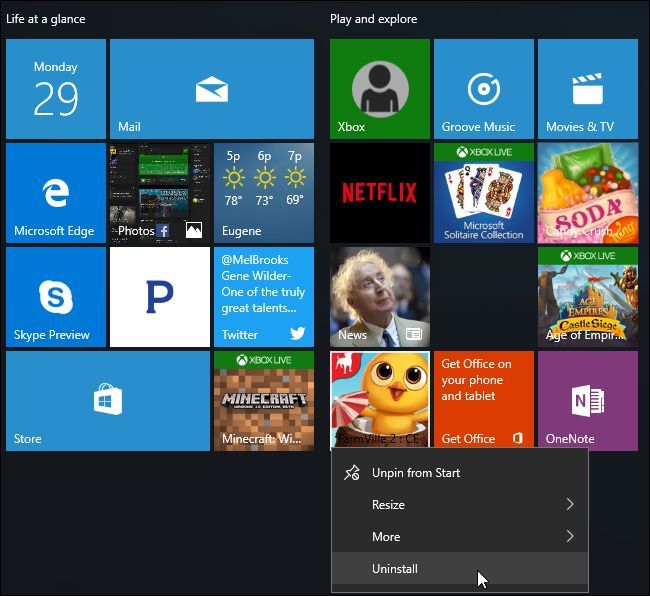
Disable Live Tiles and Unpin Windows Apps
While you can remove the apps that are installed as part of the Microsoft Consumer Experience program, Windows 10 also includes quite a few apps you can’t uninstall that advertise to you. For example, the Store and Xbox tiles often make use of the «live tile» feature to advertise apps and games Microsoft wants you to download.
To disable live tiles that advertise to you, right-click a tile and select More > Turn live tile off. You can also just right-click a tile and select «Unpin from Start» to get rid of the tile entirely. You can even choose to unpin all the tiles and only use the All Apps list to launch apps, if you like.
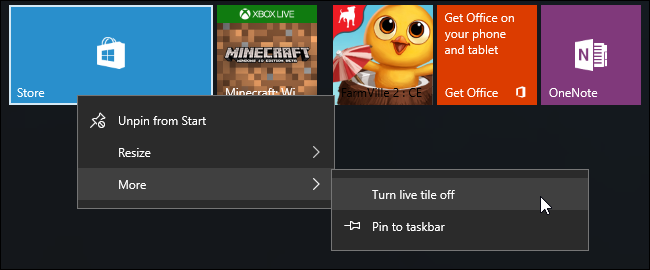
Avoid the Built-in Solitaire Game
Stay away from the «Microsoft Solitaire Collection» game preinstalled on Windows 10. This app doesn’t just have advertising—it has video ads that are 30 seconds long. You can avoid the advertising by paying $10 a year. Microsoft’s Minesweeper game isn’t installed by default, but it too has its own $10 a year subscription fee. Those are steep prices for games that used to be free.
Play another free Solitaire game instead. Google now offers a solitaire game—just search for «solitaire» and you can play ad-free solitaire in Google’s search results.
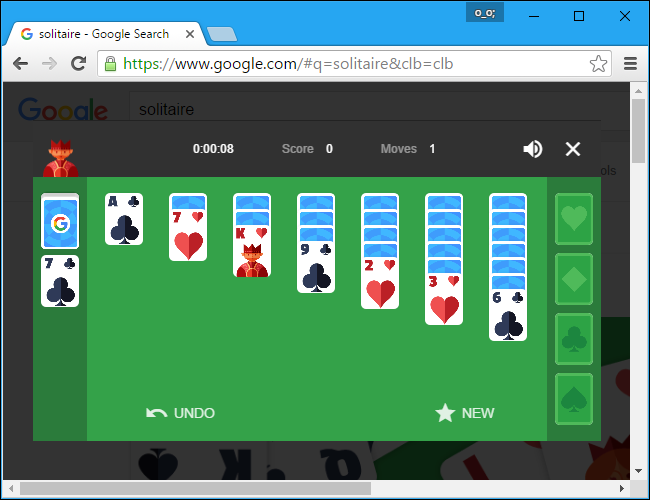
There are also completely free Solitaire and Minesweeper games on URLs that anybody can access in a desktop browser. There aren’t any ads in these games, so you can play ad-free:
solitaireforfree.com
minesweeperforfree.com
Remove Ads From the Windows Ink Workspace
The Windows Ink Workspace includes its own «Suggested apps» section which advertises pen-enabled apps available in the Windows Store. You can disable these and just visit the Windows Store if you ever want to find more pen-enabled apps.
Head to Settings > Devices > Pen & Windows Ink and set the «Show recommended app suggestions» option to «Off» option to get rid of these suggested apps ads.
You’ll only see the «Pen & Windows Ink» section in the Settings app if your PC supports pen input.
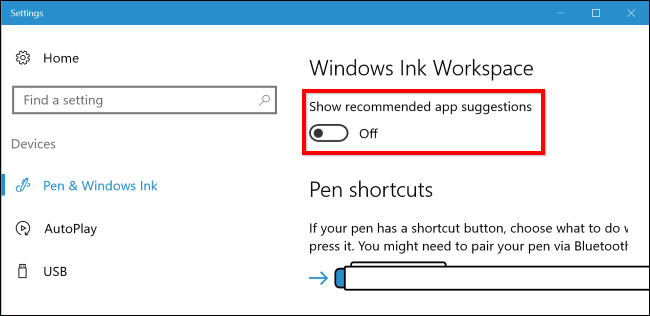
Windows 10’s Creators Update added a new Share pane to File Explorer. Click the «Share» tab on the ribbon and click the «Share» button to open it and share a file to an installed app.
By default, this dialog doesn’t just list your installed apps—it also shows «suggested» apps Windows wants you to install from the Store. To hide these suggested apps, right-click in the Share dialog and uncheck «Show app suggestions».
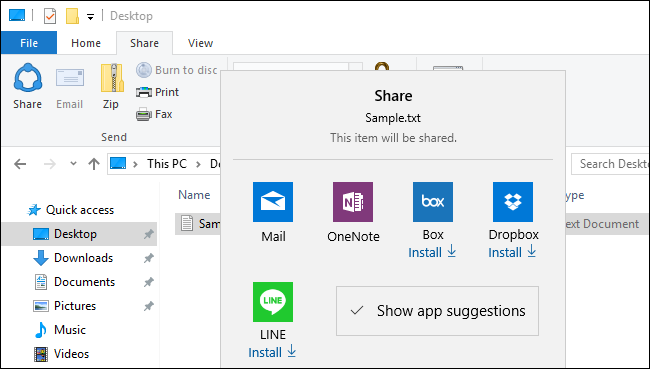
Expect to see Microsoft add more advertising to Windows 10 in future major updates. Windows 10’s Anniversary Update turned more of the default tiles on the Start menu into «sponsored tiles», for example.
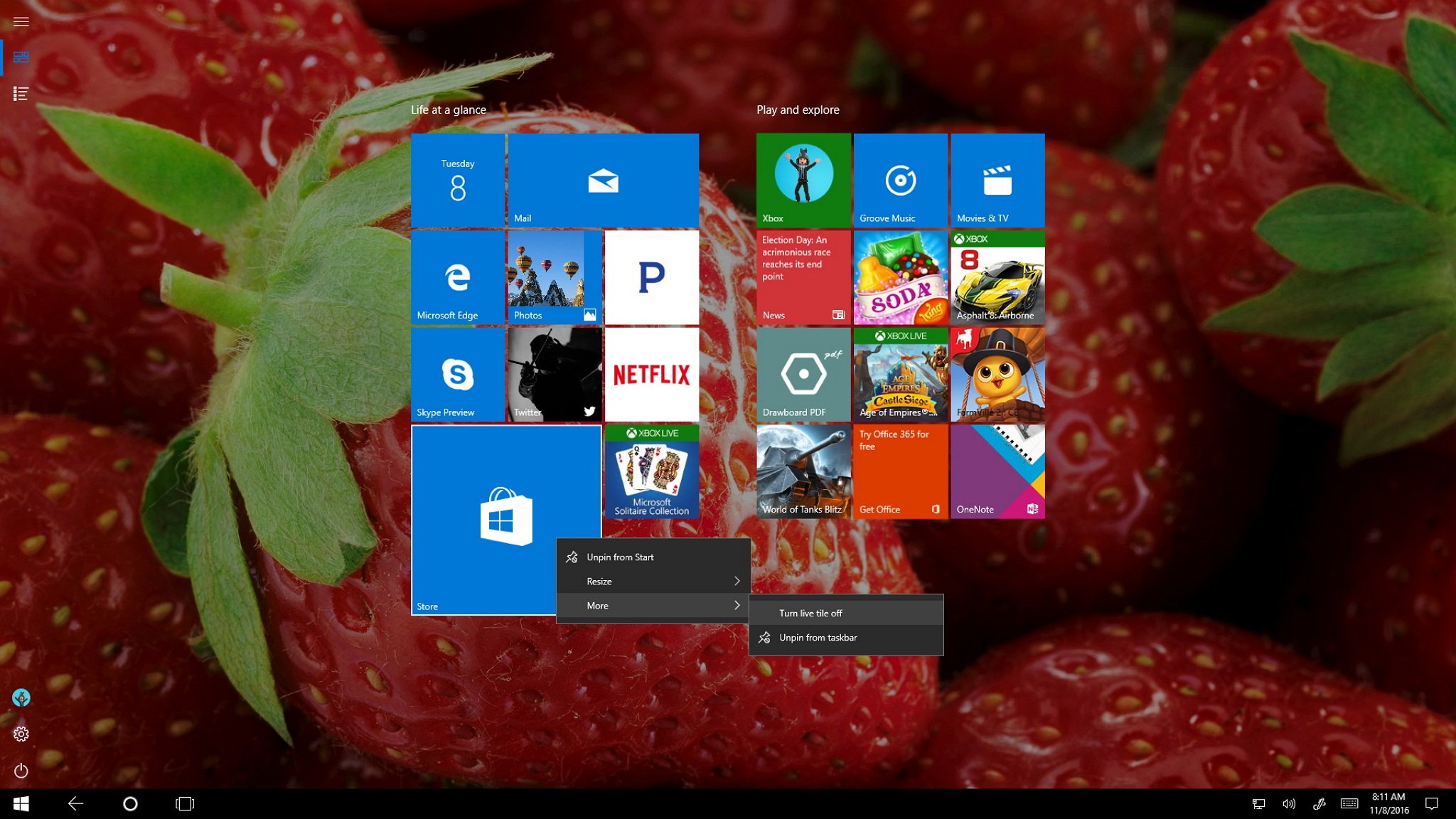
You might have obtained Windows 10 for free, but there is a hidden price, which comes disguised as ads to get you into buying apps and services you probably don’t need or want.
It doesn’t matter if you moved to Windows 10 using the free upgrade offer, it came pre-loaded on a new device, or you paid $200 for a copy of Windows 10 Pro (or $120 for a copy of Windows 10 Home), you’ll see ads everywhere — on the Lock screen, Start menu, Action Center, Cortana, etc.
Perhaps for many non-technical users, this kind of advertisements can help them to figure out the possibilities with Windows 10, but for those who work with the operating system on a daily basis may actually affect the user experience. Thankfully, Windows 10 let you disable most of these ads, as long you know where to go to find and turn off the switches.
In this Windows 10 guide, we’ll walk you through the steps to reduce the number of annoying advertisements on your device for a less irritating experience.
- Remove ads from the Lock screen
- Remove ads for the Start menu
- Remove ads from the Windows Ink experience
- Remove ads from Action Center & Notifications
- Remove ads from the Cortana search box
- Remove apps advertisement
- Remove ads from app Live Tiles
- How to stop Windows 10 displaying targeted ads
How to remove ads built-in Windows 10
Windows 10 allows you to remove most of the nagging, but there is not a master switch, you actually need to hunt down the options, which can be troublesome when they’re are scatter around, and the operating system doesn’t even call them ads. Fortunately, you can use these steps to get rid of ads on your computer.
Remove ads from the Lock screen
On the Lock screen, Windows 10 displays advertisements in two different ways: through Windows spotlight and using your own custom background.
While you can’t disable ads when using Windows spotlight, you can choose to show a custom background picture or slideshow, which includes an option to prevent Windows 10 and Cortana from showing ads on the Lock screen.
All the latest news, reviews, and guides for Windows and Xbox diehards.
To remove ads from the Lock screen, do the following:
- Open Settings.
- Click on Personalization.
- Click on Lock screen.
- In the Background drop-down menu, select Picture or Slideshow.
- Turn off the Get fun facts, tips, and more from Windows and Cortana on your lock screen toggle switch.
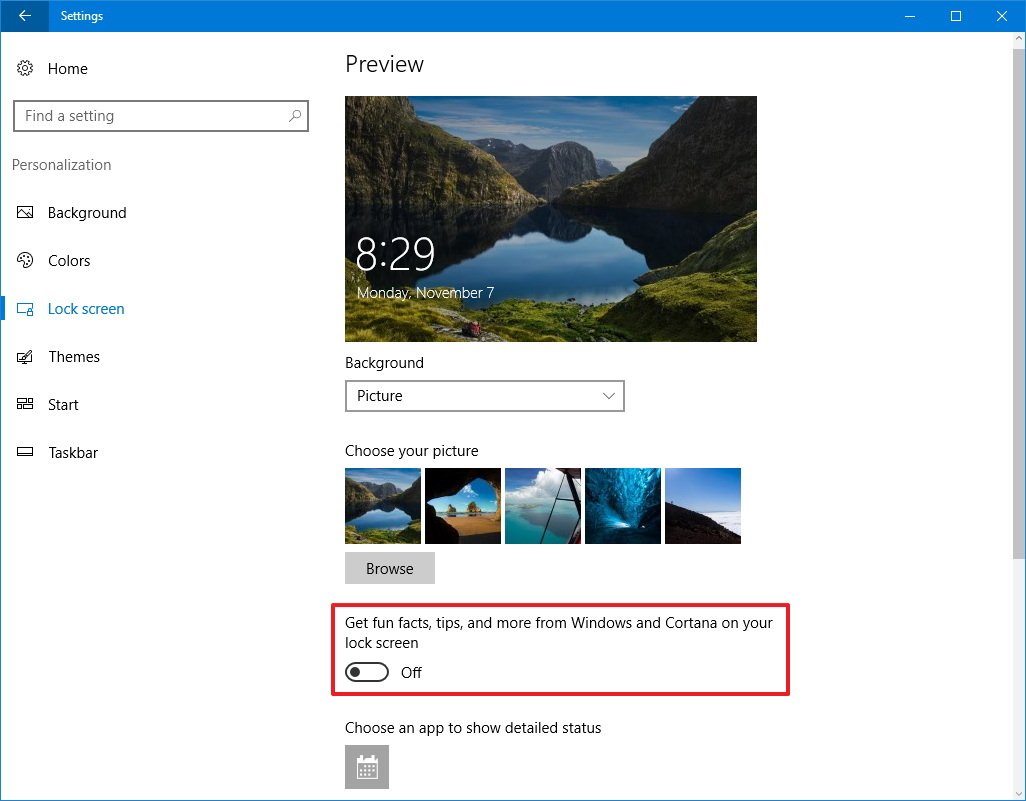
Microsoft has found a sneaky way to monetize the Start menu. They’re not called «ads,» they’re called «suggested» apps, and it’s a mean for Microsoft to lure users into getting apps and services through the Windows Store based on your behavior using the operating system.
To remove ads from Start menu, do the following:
- Open Settings.
- Click on Personalization.
- Click on Start.
- Turn off the Occasionally show suggestions in Start toggle switch.
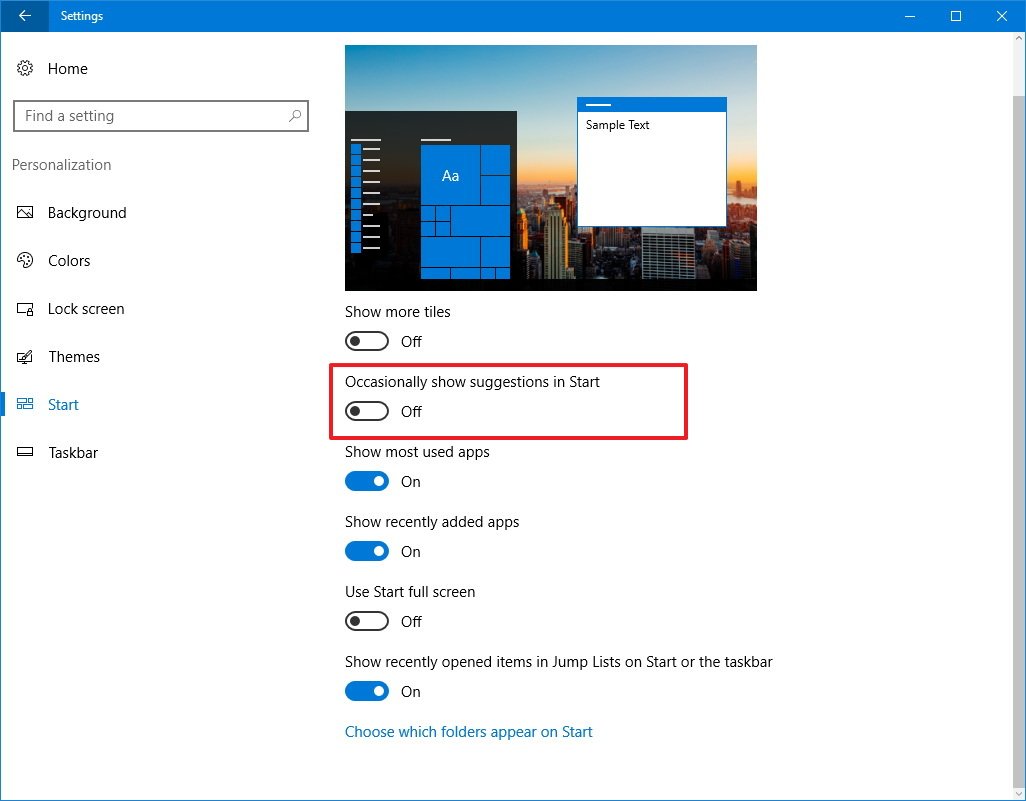
Remove ads from the Windows Ink experience
Starting with the Windows 10 Anniversary Update, the operating system also introduced a new feature called Windows Ink, which is just a new fancy name Microsoft picked for the same existing pen support, but with the promise of new improvements and features over time.
In this new pen experience, Windows 10 also displays ads in the Windows Ink Workspace to promote apps from the Windows Store that include support for Windows Ink. However, if you’re not comfortable seeing these suggestions, you can easily remove the advertisement from the Workspace.
To remove ads from the Windows Ink Workspace, do the following:
- Open Settings.
- Click on Devices.
- Click Pen & Windows Ink.
- Under Windows Ink Workspace, turn off the Show recommended app suggestions toggle switch.
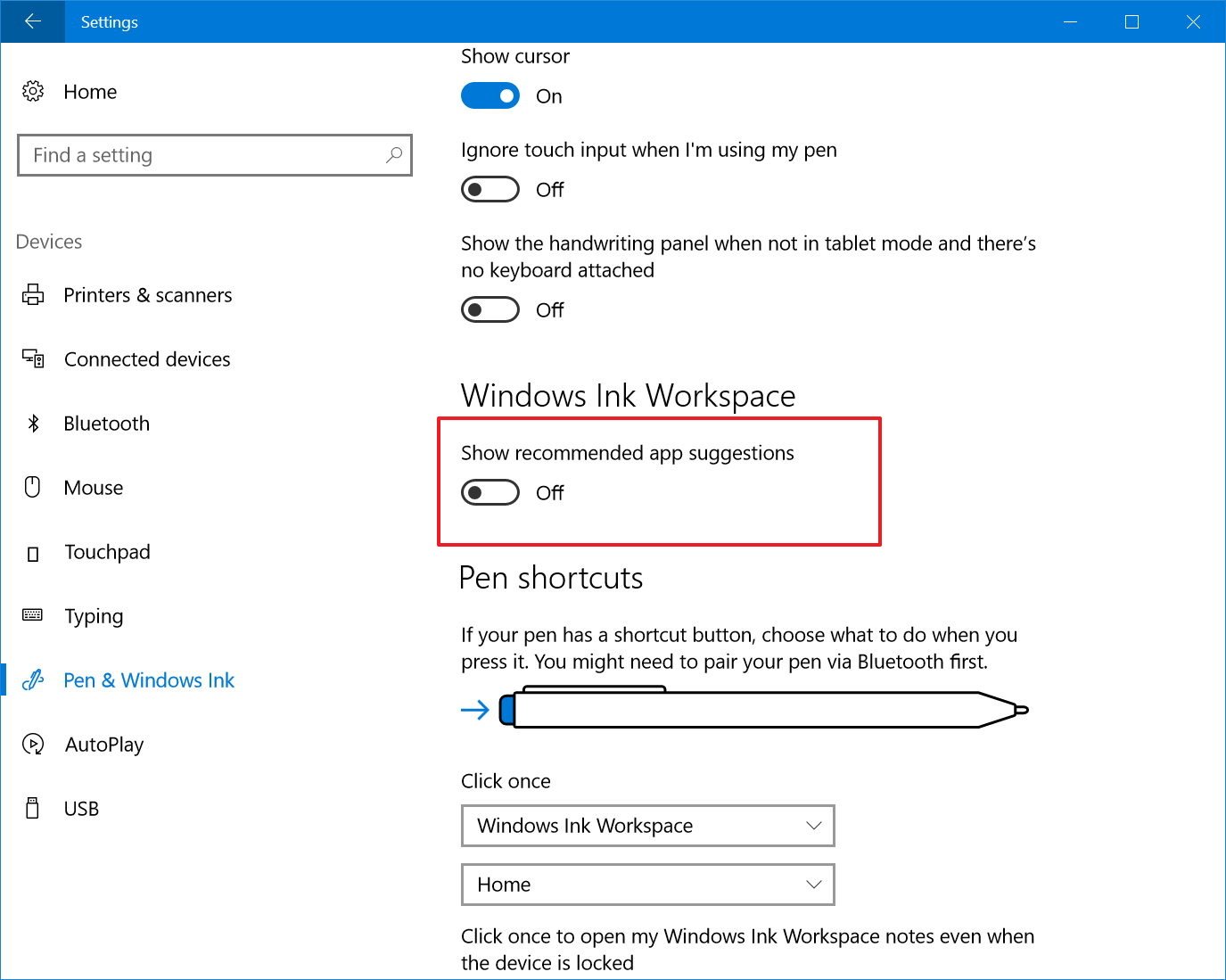
Although Windows Ink is available even on devices without a touchscreen, you can only change the option this if you’re using Windows Ink on a Surface or another device with pen support.
Remove ads from Action Center & Notifications
On this new version of the operating system, Microsoft is trying to make easier for users to find and use the new features. One way Windows 10 «helps» users is by pushing tips, tricks, and other suggestions as you use Windows through toast notifications and in Action Center.
For example, if you use Chrome at one point in time, you’ll begin getting suggestions to switch to Microsoft Edge. If you don’t want to get bothered with apps and services suggestions, Windows 10 offers an easy way to disable this form of advertisement.
To remove ads from notifications and Action Center, do the following:
- Open Settings.
- Click on System.
- Click on Notifications & actions.
- Under Notifications, turn off the Get tips, tricks, and suggestions as you use Windows toggle switch.
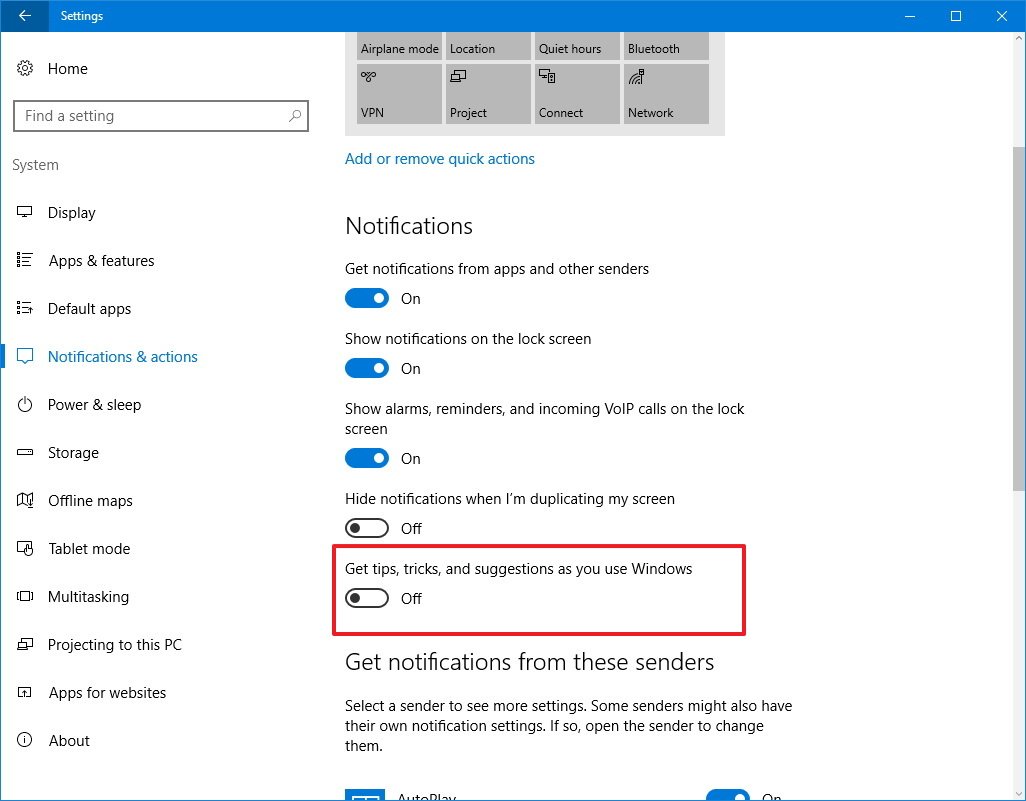
Remove ads from the Cortana search box
Cortana is your personal digital assistant that Microsoft introduced with Windows 10. While the assistant is very useful in a number of scenarios, if you don’t interact with it, the assistant will pipe up now and then to offer suggestions on how to use the feature.
Although many users may not consider these suggestions as intrusive ads, Cortana is trying to lure you into using it, which in some way, it can be considered advertisement.
If you don’t want to Cortana showing you any suggestions, you can easily disable this feature.
To remove ads from Cortana in the search box, do the following:
- Open Cortana in the Taskbar.
- Click on the Settings (gear) button on the left.
- Turn off the Taskbar tidbits toggle switch.
Remove apps advertisement
It seems that app suggestions aren’t enough on the Start menu, as Windows 10 also comes bundled with a number of apps that can be considered purely advertisement.
We’re actually talking about, the «Get Office» app and games, such as Candy Crush Soda Saga, Age of the Empire: Castle Siege, FarmVille 2: Country Scape, Asphalt 8: Airborne, and World of Tanks Blitz. Additionally, let’s not forget the Microsoft Solitaire Collection game, which also shows you long video ads if you’re not part of the premium offering.
If you don’t like to see these apps again, you can quickly remove them from your computer with just a few clicks.
- Open Start.
- Right-click the tile from «All apps» or from the tiled section, and select Uninstall.
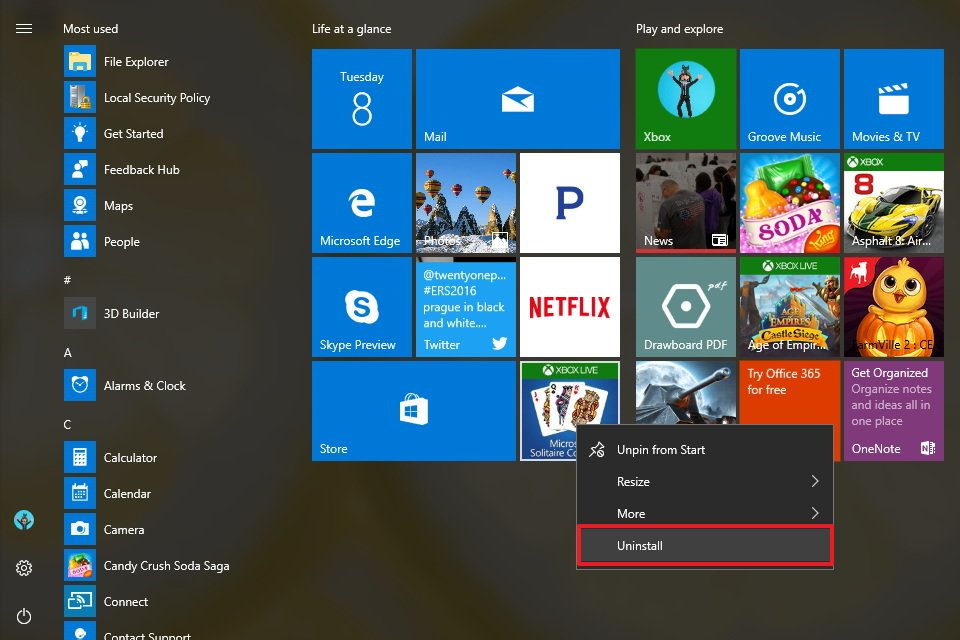
- Click the Uninstall button again to confirm and to complete the task.
It’s important to note that some tiles are simply shortcuts to download the app from the Windows Store, which means that you can simply right-click, and select Unpin from Start to remove them.
Currently, any built-in app you remove from Windows 10 will return once you install a new feature update. However, after feedback, Microsoft is making changes to prevent the apps you uninstalled from coming back in future updates. You’ll see this new change with the Windows 10 Creators Update.
We’re showing you here the steps to deals a specific number of apps, but computers manufacturers are also allowed to ship their devices with their own set of apps. However, you can use the same approach to remove any apps you don’t like.
Alternatively, you can use the Settings app do remove any app, including useless bloatware and trials:
- Open Settings.
- Click on System.
- Click on Apps & features.
- Select the app you want to uninstall.
- Click the Uninstall button.
- Click Uninstall again to confirm and to complete the task.
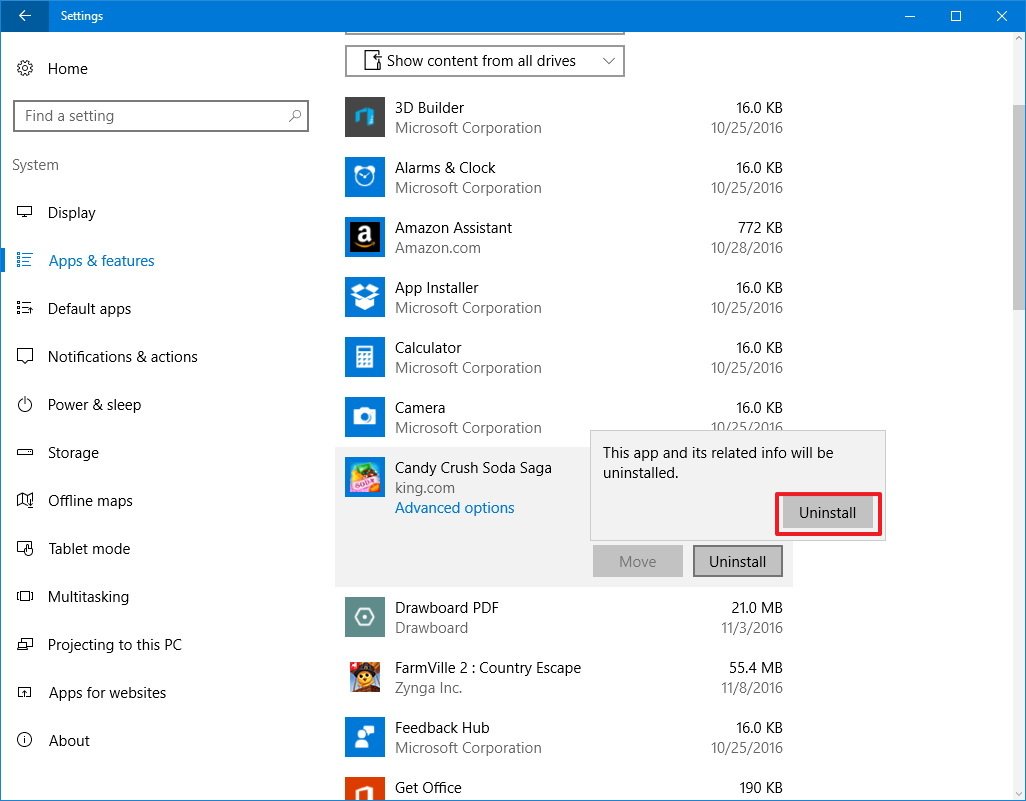
Remove ads from app Live Tiles
Although you can uninstall certain apps posing as advertisement, there are also those apps that are part of the operating system that you can’t (or shouldn’t) uninstall and often offer ads. This kind of apps can include, the Windows Store, Xbox, Groove Music, and Movies & TV.
You probably didn’t notice, but every time you open the Start menu, tiles, such as the one from the Windows Store, light up promoting apps and services, and other apps do the same too.
If you can’t uninstall the app, one thing you can do is to disable the app tile from showing updates.
To remove ads from Live Tiles, do the following:
- Open Start.
- Right-click an app tile.
- Select More.
- Click on Turn live tile off.
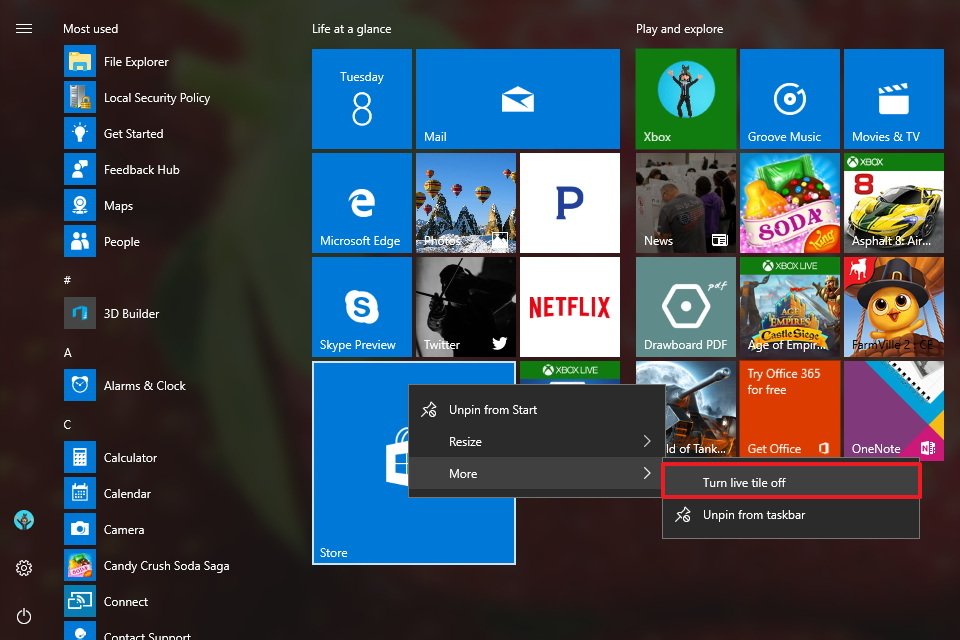
Or you can alternatively, unpin the apps from the Start menu by right-clicking the app and selecting the Unpin from Start option.
How to stop Windows 10 displaying targeted ads
In addition to the numerous ads you see in Windows 10, Microsoft also assigns you a unique identification number to track your every move in the Windows Store and on apps to target you with specific ads.
If you don’t want Microsoft to display targeted ads, you can change your privacy settings to turn off your advertising ID. However, the operating system will still be able to show ads, just not ads based on your computer behavior.
To stop Microsoft to target you with ads, do the following:
- Open Settings.
- Click on Privacy.
- Click on General.
- Under Change privacy options, turn off the Let apps use my advertising ID for experiences across apps toggle switch.
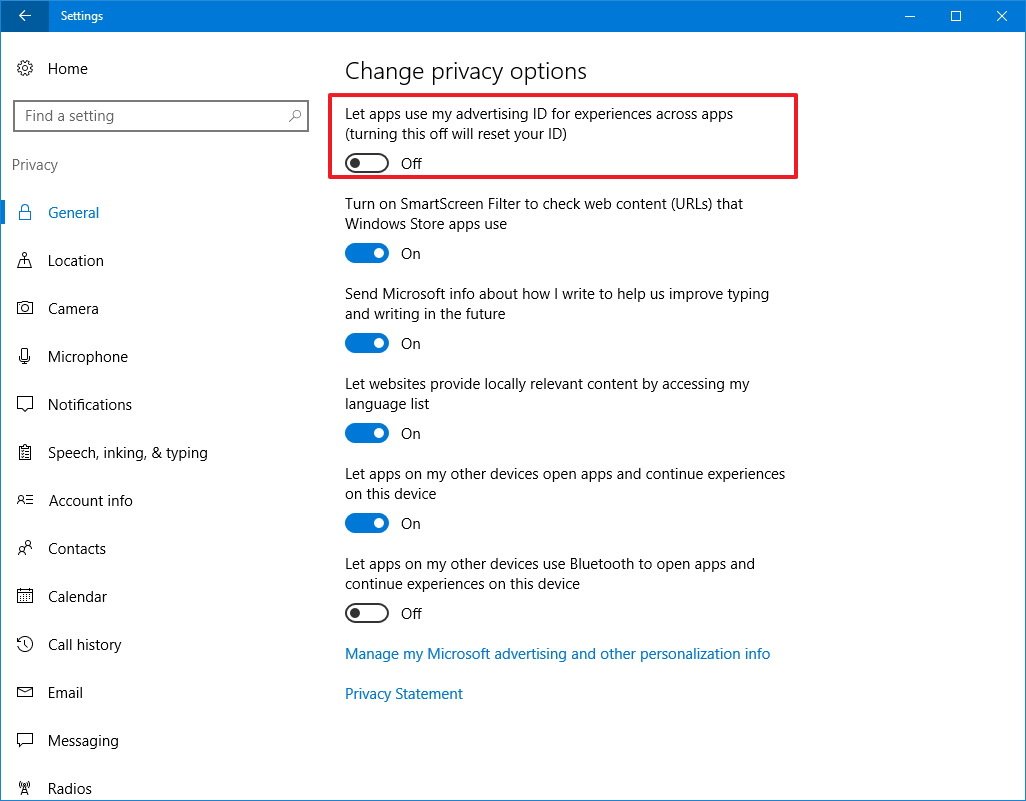
If you’re only looking reset data tied to your advertising identification number, you can simply turn off the option and then turn it back on.
Wrapping things up
Once you disable the options we’re mentioning in this guide; you’ll see the number of ads significantly reduced throughout the operating system. However, keep in mind that these options won’t remove advertisements on those apps from the Windows Store that are ad-supported. Those ads can’t be disabled.
If you’re looking to remove ads from Microsoft Edge, remember that if you’re running the Windows 10 Anniversary Update, you can install one of those popular ad blocker extensions from the Windows Store.
It’s also worth to point out that advertisement you see in Windows 10 is different to those you see when you browse the internet. Microsoft won’t show ads on the Lock screen or in the Start menu to lure you into buying new sneakers or asteroid insurance. Instead, the operating system will only nag you to get apps and services from the Windows Store.
Do you mind Windows 10 showing ads within the operating system? Tell us what you think in the comments below.
More Windows 10 resources
For more help articles, coverage, and answers on Windows 10, you can visit the following resources:
- Windows 10 on Windows Central – All you need to know
- Windows 10 help, tips, and tricks
- Windows 10 forums on Windows Central
Mauro Huculak has been a Windows How-To Expert contributor for WindowsCentral.com for nearly a decade and has over 15 years of experience writing comprehensive guides. He also has an IT background and has achieved different professional certifications from Microsoft, Cisco, VMware, and CompTIA. He has been recognized as a Microsoft MVP for many years.
Do you see ads on the Windows 10 Lock Screen, in the Start Menu, or even in File Explorer? Are you growing tired of ads on your Windows 10 PC, laptop or Surface Pro? Do you want to have an ad-free experience in Windows 10? If you do, you are in the right place. In this tutorial, we show you how to completely turn off all the ads that Microsoft bluntly sends our way in Windows 10. Read on to see how to make your Windows 10 PC or device, ad-free:
1. Disable the ads from the Windows 10 Start Menu
Unless you decide to do something about it, Microsoft has the annoying habit of showing so-called «promoted apps» on your Start Menu. You’ve probably already seen them — they look like in the picture below:
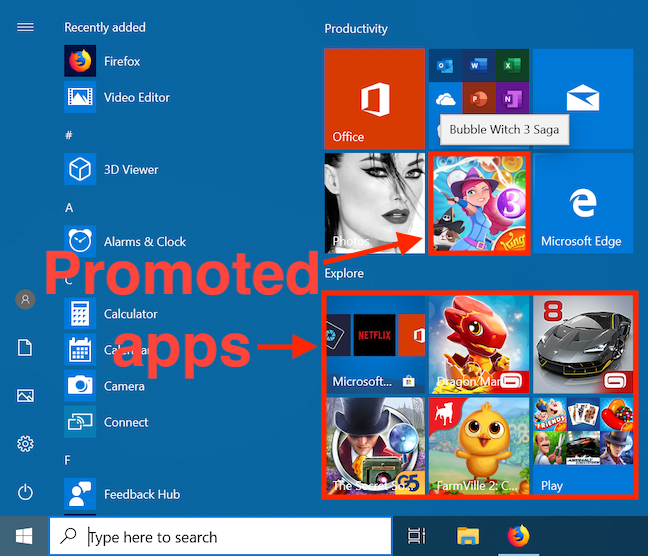
If you want to get rid of them, all you have to do is follow this guide: Stop Windows 10 from promoting apps on the Start Menu.
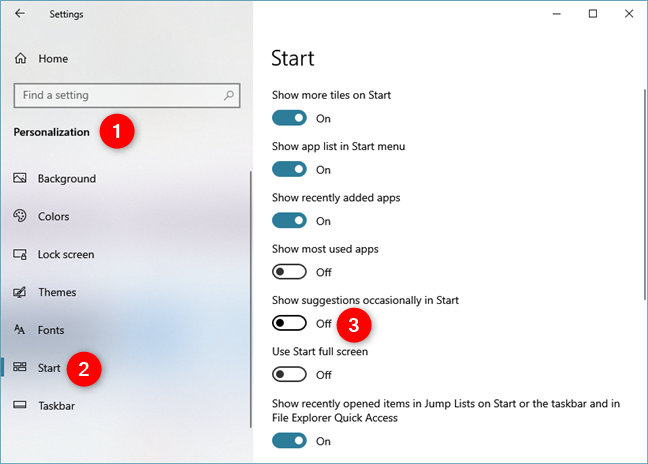
Once you do that, Windows 10 should stop displaying ads on your Start Menu.
2. Disable the ads from the Lock Screen
Another place that Microsoft thought would be an excellent billboard for its ads is the Lock Screen. You probably saw ads like these:
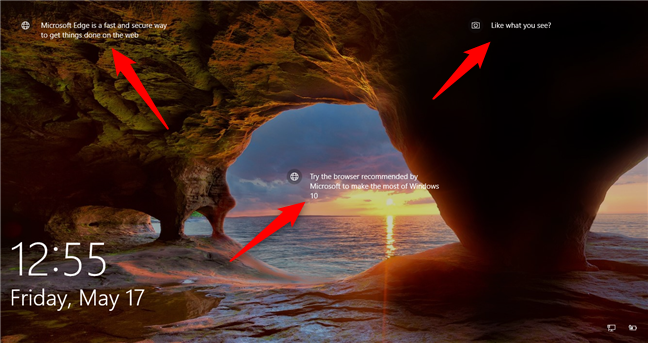
Although the ads on your Lock Screen are not as invasive or annoying as the ones displayed in the Start Menu or File Explorer, they can still bother you.
If you want to disable these advertisements, open the Settings app. Navigate to Personalization -> Lock screen. On the right side of the Settings window, scroll down until you find an option saying you can «Get fun facts, tips, and more from Windows and Cortana on your lock screen.» By default, it’s turned On. Set it to Off.
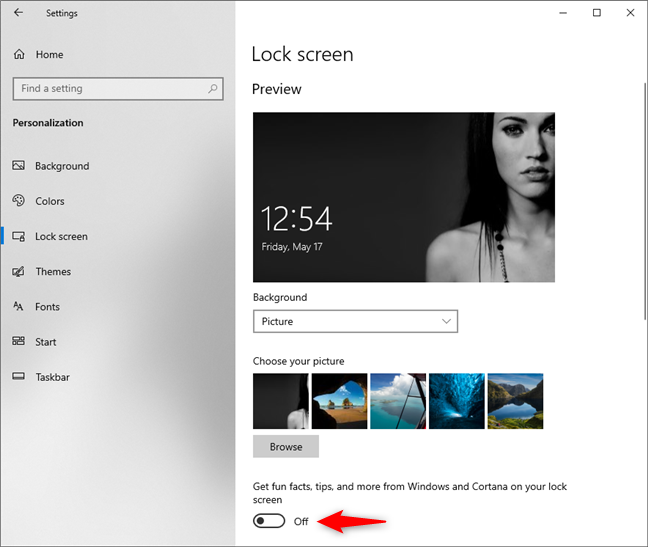
From now on, your Lock Screen should be free of ads.
Note: The «Get fun facts, tips, and more from Windows and Cortana on your lock screen» setting is available only if you chose to set a Picture or a Slideshow on your lock screen. If you chose Windows Spotlight, this setting isn’t available.
3. Disable the ads from File Explorer
In Windows 10 Creators Update and later (including in May 2019 Update), Microsoft also shows ads in File Explorer, which is something that we did not expect. Some people hate them, and for good reason. The most common ads share offers for cloud storage with OneDrive, or for Office 365 subscriptions.

Luckily, you can disable the ads from File Explorer. To do so, launch File Explorer, and open the View tab from its ribbon. Then, click or tap the Options button. It is the last one to the right.
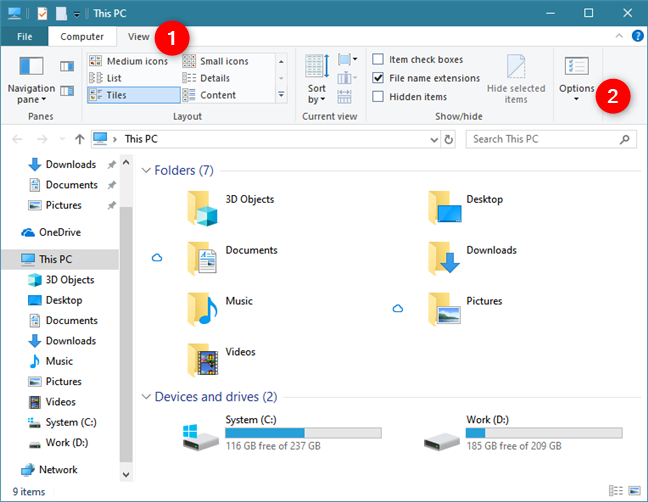
Then, in the Folder Options window, click or tap the View tab and scroll down the «Advanced settings» list. When you find the setting called «Show sync provider notifications,» uncheck it. This setting controls whether File Explorer shows ads or not.
Click or tap Apply or OK to save the changes that you have made. From now on, there shouldn’t be any ads displayed in File Explorer.
4. Disable the ads that show up on the taskbar
You might have also seen ads and popups showing up from your taskbar. For example, from time to time, Windows 10 might send you «recommendations» for using Microsoft Edge because it is better than the competition. If you do not want to see these ads, open the Settings app, head to «System -> Notifications & actions,» and disable the «Get tips, tricks, and suggestions as you use Windows» setting.
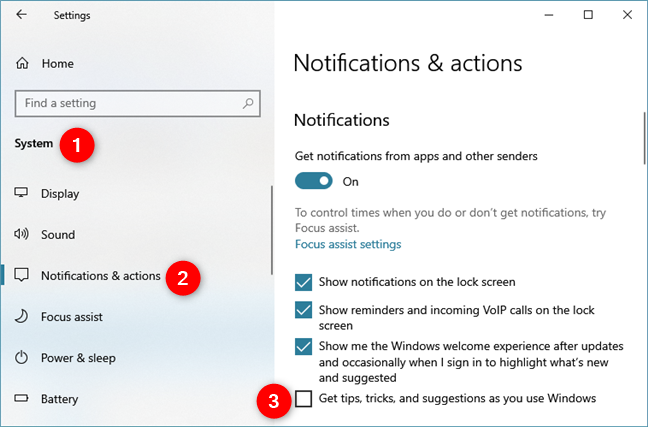
5. Disable the ads notifications that show up in the Action Center
Windows 10 also has a habit of showing ads as notifications in the Action Center. For instance, it might show such «suggestions» if you just installed or upgraded the operating system, or if you did not finish configuring Cortana or Microsoft Edge.
To make sure that you do not get these types of advertising notifications, open the Settings app, navigate to «System -> Notifications & actions,» and disable «Show me the Windows welcome experience after updates and occasionally when I sign in to highlight what’s new and suggested.»
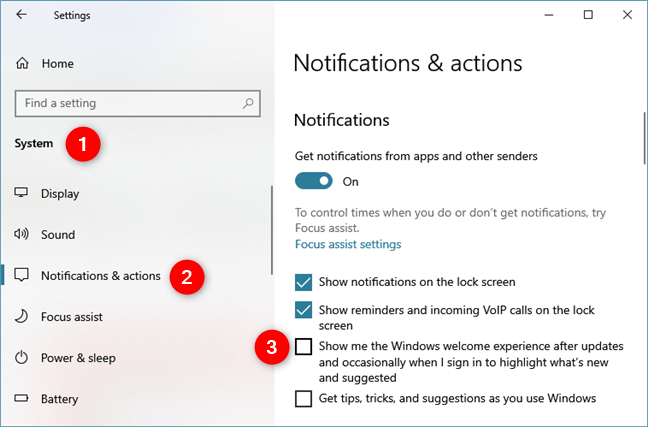
Did you see ads anywhere else in Windows 10?
Now you know how to get rid of all those annoying ads that Microsoft displays in unexpected places in Windows 10. Turning ads off can make Windows 10 a friendlier operating system Unfortunately, it looks like Microsoft won’t let go of advertisements, even if you have already paid for their operating system. What do you think about this tactic? How much time did it take you to disable all the ads? Did you wait for a while, or did you disable them as soon as you installed Windows 10? Comment below and let’s discuss.
